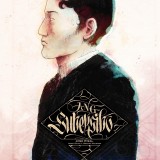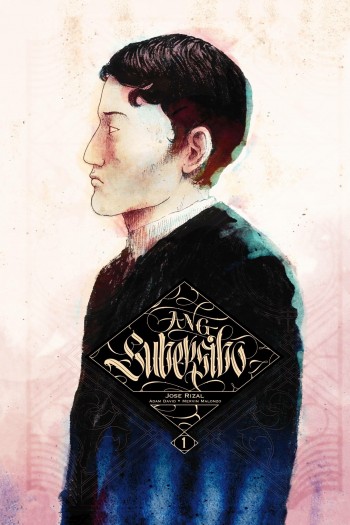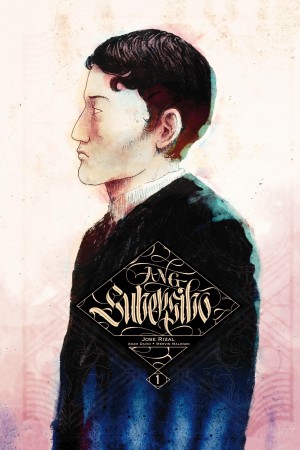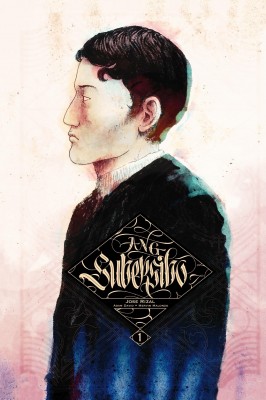
COMIC BOOK REVIEW: Ang Subersibo, Unang Isyu
With so many books, studies, articles, and even comics about one of Philippines’ national heroes, Jose P. Rizal, what more can we expect something fresh and more importantly, creative from his supposedly life and his works, and the milieu surrounding him? He is definitely a challenge for both young scholars and even to the creative […]
With so many books, studies, articles, and even comics about one of Philippines’ national heroes, Jose P. Rizal, what more can we expect something fresh and more importantly, creative from his supposedly life and his works, and the milieu surrounding him? He is definitely a challenge for both young scholars and even to the creative minds because he is the most studied hero in the Philippines, the most number of biographies attributed to his life and legacies, and one of the most numerous artistic themes or inspirations in the visual genre in Philippine comics. In short, what more one can contribute something novel about him unless one resorts of recreating the scenes from his two novels, Noli Me Tangere and El Filibusterismo, which are also two of the most favorite novel-to-comics adaptations in Philippine setting (proof, their respective comic book versions are still available in leading bookstores nationwide). In other words, the name Jose Rizal still poised a serious hindrance for intellectuals and artists alike in the realms of creativity and innovations, if not sheer originality.
However, there are few brave souls who actually pick up the gauntlet and prove naysayers, doubters, skeptics, cynics, pessimists, and even pretentious types so very wrong that they can make Jose Rizal and his two influential novels more relevant, significant, refreshing and ultimately, worth emulating to the generation of millennial, and the reinvigorations of the Rizalian literature and studies as well. Among these daring spirits are Adam David and Mervin Malonzo in their tribute to the Renaissance man’s greatest literary legacies, entitled, ANG SUBERSIBO, UNANG ISYU (or simply translated as Subversive). It is definitely a multi-volume magnum opus of the David-Malonzo collaborative creative effort because re-interpreting both Noli and El Fili both visually and even narrative is neither as simple as it seems nor as innovative as it was already accomplished before then. One good example was one of Rizal’s closest friends and Philippine’s distinguished painters, Juan Luna. The painter of the Parisian Life (as the creative team utilizes here), Spolarium, and The Battle of Lepanto actually drew illustrations on the selected scenes of Noli Me Tangere which was originally planned to be released as a new edition that was never made. In addition of the movie and television adaptations of the novels that proves more difficult to craft another creative and intriguing perspective of the trials, struggles and path to perdition by the books’ main character, Crisostomo Ibarra/Simoun. However, the Subersibo creative minds grab the bull to it’s horns and do the nigh impossibility, with both promising and hopefully in the end, incredible results. True, this is only an introductory visual literary appetizer, clocking about sixty pages, and possesses a couple of interesting features, like David’s introductory and anecdotal notes that are actually extensive and even includes a reference for proof-checking, and most of all, Malonzo’s meticulous sketches and some preliminary art that are truly evidences of the artist’s next evolutionary artistic process. Henceforth, this comic book is one of the most innovative works in Philippine historical visual re-interpretation ever!
The foreword sets the stage in the interiors for we can fully understand and appreciate why the writer undertakes this herculean task: his not-so-pleasant classroom experiences on studying Rizal’s novels (remember your third and fourth year high-school Filipino years, senores y senoras!), and his personal readings with the novels themselves (actually, they are humorous, serious, witty, satirical, and oozing with Philippine culture of the Tagalog 19th century period, most especially with Noli Me Tangere, Rizal’s personal favorite). And reading between the lines and the list of references he enumerates, he obviously admires popular historian and the leading Rizalist of our generation, Ambeth R. Ocampo. Indeed, the interiors are narrated in the reconstruction of the late 19th century Manila-Tagalog as much as possible, if not as authentic as been. If consulted the preferred Noli and El Fili Tagalog-Filipino translations, David chooses the right one, National Artist in Literature Virgilio Almario’s versions (if only the Paciano Rizal’s Noli-Tagalog translation is still around, but alas, this Rizal’s approved and first vernacular translation was vanished when his elder brother died in the 1920s, and still yet to be resurfaced). Moreover, this initial chapter almost reads and feels like watching another postmodern, if not thought-provoking, Rizal movie in the late 1990s, Bayaning Third World, which puts or emphasizes the perspectives of everyone else, not solely for the “serious” types, you know, the academicians and/or specialists’ points-of-view. However, the creators make sure that the core message of the good doctor remains the same as much as historically possible. Yet, David’s and Malonzo’s take on the national hero and the books are presented boldly, revisiting the novels’ initial significant moments, and moreover, making the new and old readers to rethink our previous positions regarding the Great Malaya.
If David’s initiative is remarkable, what more can we say about Mervin Malonzo’s painstakingly illustrations of the 1880s Manila settings and milieu, most particularly the city’s economic hub then, Binondo. With the minor exceptions due to some artistic licenses as mentioned in the afterword/anecdotes, the Manila illustrated in Malonzo’s hands is so alive and kicking, bustling with energy similar to today’s economic centers like Makati and Quezon City. The illustrator retains many of the city’s landmarks and even some mundane and trivial details that are already, well, history, such as bancas in Pasig River, calesas, and even the tranvias plying their respective routes. Similar to Malonzo’s respect to historical references and their contextualization, the artist also does the same via detailing the illustrations from some available historical documents like city outlines and/or blueprints, maps and photographs that can be found in credible Philippine history websites. Even the conversations, dialogues, and interactions of the inhabitants are felt lively and more alive than ever, making proof that Manila was not as bad as what it is nowadays. Most significant is the illustrations are directly influenced (or homage, actually) to the highly seminal and influential independent work in visual literature, Alan Moore-Eddie Campbell’s From Hell. Underlying the great toast for the newly arrived “illustrado” in Manila is the great mysterious and even more nefarious and potent things to come for our beloved Rizal-often represented archetype through Malonzo’s highly detailed, quasi-hypnotic, and mesmerizing interior artwork. His paneling are indeed conventional, as they should be in respecting both the creative minds of From Hell and to Rizal’s milieu and environs (it should be noted here that From Hell sets in 19th century Victorian Age England, which the doctor/man-of-letters came, lived, and even worked his second book there when the infamous Jack The Ripper also committed a series of methodological grisly murders there). The facial features and portrayals are remarkably faithful to the spirit and/or essence of the hero’s characters, especially the governor-general (or “capitan-heneral”, reflecting the military rank and stature), the ilustrado, and naturally, the most infamous friars in Philippine literary history. Simple yet very effective, and more so, Malonzo’s artistic executions are virtually stunningly perfect in recapturing the metropolitan zeitgeist of the 1880s Manila and the re-imagining of the novels’ iconic casts, even Rizal himself. Once again, this is only the beginning. Thus, Ang Subersibo can be considered as the illustrator’s most challenging and even probably greatest artwork so far. I cannot wait for more “subversive” illustrations sooner than later.
Furthermore, this groundbreaking graphic re-interpretation presents plenty of deconstructive tropes in decoding the potential signifiers the creative team probably wants the readers to visualize while the narrative unfolds. From Rizal’s supposed breaking the fourth-wall challenge, of making sense of Luna’s controversial opus, the uncovering of the often cited “tumor” of the novels’ texts (though arguably, they are Almario’s Rizal, not Rizal-Rizal’s). Good thing, David explains some of his thoughts and supposed representations in the end part, that may or otherwise influence future literary and visual scholars in decoding, de-contextualizing, and deconstruct the writer’s labyrinth, if they can dare so. Like for example his musings on the first Philippine authentic cuisine ever cited in Noli, the “tinola”. And I personally thought religions and ideologies were the only abstracts/thoughts/beliefs that could be branded as “opiate of the masses” and “shabu of the intellectuals”, respectively. But regarding with opium, it was very much legal in Spanish-Philippines during the 19th century, thus the existence of Capitan Santiago’s primary vice in Binondo, more specifically. The parameters were rather strict though, one must have Chinese-blood and most importantly, moneyed. This vice was ultimately outlawed when the so-called “Progressive-minded” American enforcers put the stop on it in the first decade of the 20th century. Moreover, expect more “prayle”-moments to come in the succeeding chapters, but let us remind new readers here that Rizal personally never generalized all the priests as such, but the damage was already done by him, his fellow reformists/propagandists, and much later on, the Americans and the nationalist historians as well. The “black-and-white” theme that originates from Rizal’s books remains faithfully.
My only misgivings here in this superb postmodernist interpretative visual literary opus are two-folds. One, David’s scripts may be exceptionally well-crafted, but the lettering are too small to read, especially for some readers around. It becomes a bit problematic even when the main characters’ dialogues are also difficult to browse unless one focuses more. And two, as what I commend above on the writer’s vision of historical authenticity in the graphic medium, I have to be honest here that the texts utilize here are way too anachronistic, most particularly for young and new readers, and even to some jaded counterparts. This often reminds yours truly the collective experiences of past and present students’ bemoaning on the deep Tagalog wordings they read on the novels’ Tagalog translated versions during their secondary schooling years. Or maybe, playing devil’s advocate here, this nitpicking may serve as a challenge to ourselves of looking back and relearn Rizal’s 19th century Tagalog at all. In short, consider these criticisms as the work’s mere asterisks; while the rest is a true rare visual literary gem.
Summing up, Ang Subersibo, Unang Isyu is not just another rehash of the life and works of the country’s premier national hero, particularly his Noli Me Tangere and El Filibusterismo. It is the exact contrary, I say, for the collaborative artistic efforts of Adam David and Mervin Malonzo are both beyond our expectations, and even surpass their current respective artistic repertoires as so. This work is a refreshing retelling and reinterpretation of the martyr’s greatest literary opuses without even diminishing or tarnishing the true core essences of these iconic and seminal literatures, and to greater extent, Rizal’s grand message to the Philippine readers, then and even now. Of course, there are minor tweaks along the way, but the collaborative-creative efforts, respect to historical sources and the contextualization of these, the overall artistic delivery and execution, and retaining and maintaining the doctor’s literary legacies, make Ang Subersibo truly subversive, literally and figuratively speaking.
SALUD!



















Gonna look for a copy now.